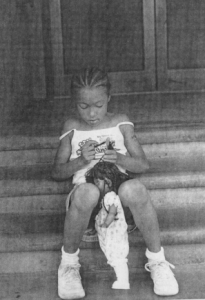Black Presentation and Authenticity through Photography
who’s hair isn’t done / let me get in that head honey / the day is lace and crinolines / curls, satins, and layers of beauty / who’s mama wouldn’t be proud / who’s eye won’t be turned when / i saunter outta this room where / the magic is and become it – The Sweet Breath of Life
And they has a party every Saturday night / usually not no big party / Just neighbors and home folks…But it’s nice to young folks all dressed up going somewhere–maybe to a party. But it’s sad if you ain’t invited.
The Sweet Flypaper of Life
A number of continuities exist between Shange and Kamoinge’s The Sweet Breath of Life and Langston Hughes and Roy DeCarava’s The Sweet Flypaper of Life, including authentic representations of black families and neighborhoods, and the power of pairing image and text.
One important continuity between the two pieces is the depiction of “doing hair” as a method of presentation, bonding, and self-care. Another continuity between the two pieces is “the porch” which serves as a barrier between the home and the street. The porch could be seen as a barrier between what black people present on the outside and what they experience on the inside. It could also be seen as a communal, intergenerational space for family and loved ones to gather, or a connector between the inside and the outside.
The exploration of porches and doing hair in both pieces facilitates a better understanding of black photography, specifically. Photography’s preoccupation with ideas like presentation, authenticity, intimacy, etc. uniquely intersects with ideas of self-identification, performativity, and erasure that permeate blackness and the black experience. This series of images and text presents black people’s daily life rituals, like sitting on the porch or doing hair, as involved in their experience with presentation and authenticity.
As we continue exploring Shange’s work, it is important to recognize the ways that black people seek to present themselves, the ways that image/text can present blackness and black people, and to what degree we can find authenticity in these presentations.



Comment ( 1 )